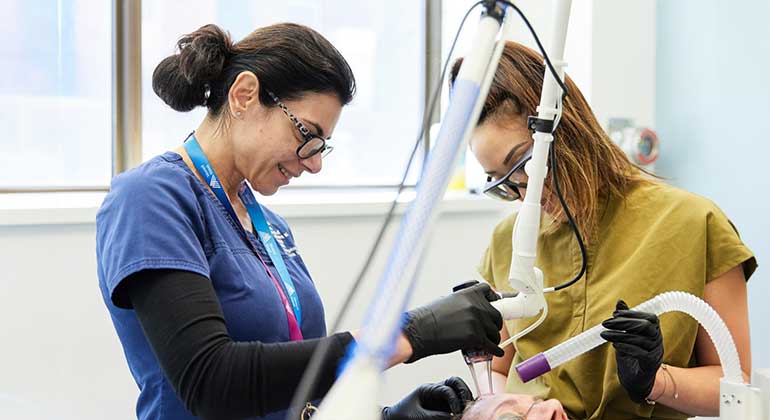Laser Resurfacing

Laser resurfacing is a minimally invasive cosmetic treatment that can help rejuvenate and repair the skin and provide a more youthful appearance. At Mount Sinai’s Division of Facial Plastic and Reconstructive Surgery, patients have access to the safest and most advanced laser technology available.
Our facial plastic surgeons and advanced practitioners are certified to perform laser treatments for everything from aged skin, to sun damage and facial scars (including surgical scars and acne). Under the auspices of a major medical center, we operate under strict oversight and adhere to the highest possible safety regulations when utilizing laser technology.
Benefits of Laser Resurfacing
While surgery is used to tailor or reshape the appearance of the face, laser treatments are used to enhance the quality of the skin particularly from the effects of aging. The use of lasers in cosmetic treatments has grown significantly over the last decade; today nearly 600,000 laser resurfacing procedures are performed each year in the U.S. according to the American Society of Plastic Surgeons.
Laser resurfacing can improve the appearance of:
- Blemishes and spots, including those from melasma and sun exposure
- Facial aging including fine lines and wrinkles on the face, neck, and hands
- Surgical scars (learn about the Mount Sinai SCARS Program)
- Acne scars
- Smoker’s lines
- Large pores
- Uneven skin pigmentation
- Redness from conditions like rosacea
How Laser Resurfacing Works
The use of lasers was pioneered in the medical field more than sixty years ago. Researchers found that using high-energy focused beams of intense “single-colored” light could produce different effects on the body. The light, and the resulting heat, of a laser have been found to interact in very useful ways with various tissues in the skin and body. Today, lasers are used in a variety of medical applications, and including their extensive use for cosmetic treatments (fun fact: the word ‘laser’ is actually an acronym, Light Amplification by Stimulated Emission of Radiation).
Types of Cosmetic Lasers
There are numerous laser resurfacing options available today. At Mount Sinai, we only use lasers that have been approved by the FDA and are commercially available. Our team works with each patient to determine what treatment is right for them depending on their goals and desired recovery time.
There are two major categories of laser treatments: ablative and non-ablative. Our cosmetic surgeons and advanced nurse practitioners perform a high volume of both procedures. In general, ablative techniques are more invasive and tend to have more “dramatic” results with a single treatment. Non-ablative laser treatments require little to no downtime, but their best effects are realized over multiple treatments.
Ablative Laser Treatments
In an ablative technique, the laser destroys the outer layer of skin. This allows the skin to heal and regrow. Since the outer layer of skin is removed, patients require a between three days to a week of recovery time. There are two main ablative treatment options:
- Fractionated carbon dioxide laser skin resurfacing (FXCO2) is a popular, permanent treatment that improves the appearance of aging skin including fine lines and wrinkles, increased pore size, skin blemishes, and uneven skin pigmentation. At Mount Sinai, we use the Lumenis Accupulse system, a state-of-the-art resurfacing workstation for a variety of aesthetic enhancements.
- Erbium laser resurfacing (YAG) is effective for removing moderate to deep fine lines and wrinkles. The benefit of the erbium laser is precision. There is minimal damage to the surrounding tissue.
At Mount Sinai’s Division of Facial Plastic and Reconstructive Surgery, FXCO2 and Erbium Laser Resurfacing can be performed in the office with local anesthesia or as part of a larger surgical procedure. The results are not immediate, and patients will continue to see the effects develop over the following months.
Non-ablative Laser Treatments
During non-ablative treatments the laser heats up and burns the outer layer of skin but does not damage it. The procedure stimulates the body’s natural collagen production to reduce unwanted fine lines and wrinkles.
Since the outer layer of skin is not removed, patients typically need to repeat the treatments for a few months to achieve the desired results. However, less recovery time is also needed. Patients may experience up to two days of redness, but they can still go to work and put makeup on. There are two main non-ablative treatment options:
- The Lumenis M22 platform has multiple laser types including IPL, ResurFx (non-ablative fractional resurfacing) and Nd:YAG.
- PhotoFractional Laser Resurfacing is Mount Sinai’s most commonly used non-ablative treatment. The procedure combines the IPL and ResurFx laser resurfacing technology.
After Laser Treatments: What to Expect
Laser treatments are not a replacement for cosmetic surgery. Depending on the type of system that is used, patients will see either immediate results or notice changes over the next few months. Many of our patients bundle treatments together to minimize overall recovery time. For example, laser resurfacing can be done at the same time as an eye lift.
Cost of Laser Resurfacing
Cost is always a concern, as insurance does not generally cover surgery or treatment that is done purely for cosmetic reasons. We provide patients with expected costs prior to any intervention.